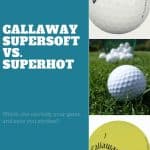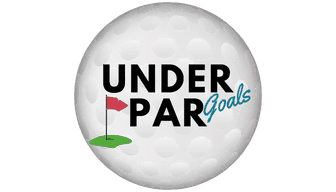What’s The Difference Between Callaway Supersoft vs. Superhot Golf Balls?
The main differences between the Callaway Supersoft and Superhot are the lower compression rating of the Supersoft (38 compared to 50), the lower spin characteristics of the Superhot, and the Superhot favoring distance over spin and control.
The battle is the Callaway Supers! So I wanted to do this comparison because, at first glance, it might seem like these balls are for very different golfers due to the names. However, they do have a lot of similarities (other than just having “super” in the name). So let’s compare the Callaway Supersoft vs. Superhot golf balls…
However, both are excellent options for golfers that haven’t yet reached the level of play necessitating a premium golf ball. If you want to check out the current reviews on Amazon, you can CLICK HERE for the Callaway Supersoft and CLICK HERE for the Callaway Superhot.
If you want to see more great options check out our buying guide for the best golf balls.
Contents
- Callaway Supersoft vs. Superhot Comparison Table
- Callaway Supersoft Review
- Callaway Superhot Review
- What’s The Verdict?
Callaway Supersoft
Feel
It’s easy to figure out how this ball is going to feel. It’s right in the name.
This ball is soft and you’ll be able to tell that right away. For a lot of golfers, this can take some getting used to and some never really warm up to the soft feel. But if you remember and long for the days of wound balata balls then this might just be the modern answer.
I found that they felt a little mushy at driver swing speeds over 100mph, but with a lower swing speed, the ball feels more solid.
Spin
This ball is able to keep the spin under control on the longer clubs like the driver while still having such a low compression number, which makes it very desirable for players with a slower swing speed.
As for short game spin, that really depends on the cover material. That’s because chips and pitches are struck at lower swing speeds so the core of the ball is not compressed very much. Typically, surlyn (or ionomer) covers are harder than urethane covers and give you less spin on lower swing speed shots like pitches and chips. The downside to urethane cover balls is that they usually cost more.
Callaway claims that their cover is better than the usual ionomer cover. In my testing, comparing it to urethane cover balls and other surlyn cover balls, I will say that Callaway did accomplish that. The greenside spin with this cover is definitely better than other surlyn cover balls but not as good as a urethane cover.
Driving
This ball performs great off the driver for those of you with slower driver swing speeds (under 90mph).
In fact, you will probably see distance gains off the driver if you are switching from a harder golf ball like a ProV that was really designed for fast swings.
Comparing this to the Superhot…I would give the win to Superhot for driving. The Supersoft results in more backspin off the driver which can tend to cause higher ball flight and less roll out. That means shorter drivers than the other option below.
Putting
The soft feel of this ball can be a big benefit for putting.
Everyone has different styles of putting and as long as you are consistent with your stroke, they can all work. But I think a softer ball on the green can encourage a more aggressive and confident stroke. Most amateur golfers miss their putts short which means the ball never has a chance to go in.
The Callaway Supersoft can cure that habit by subconsciously making you hit it just a little more aggressively because it feels so soft. This ball is definitely the winner on the greens out of these two.
Overall
Overall, this is a great, high-quality golf ball for a very good price.
It has a good balance of control and distance. There aren’t enough low compression balls on the market and this is probably one of the best of the bunch. It made our list of best low compression golf balls.
Who Is This Ball For?
Well if you haven’t figured it out already, this is a great ball for those of you with slower swing speeds who don’t want to spend the money on a premium golf ball. It has the soft feel of the much more expensive Callaway Chrome Soft. While it doesn’t spin like that ball, it will give you a little help around the greens.
If that sounds like it might fit your game, you can CLICK HERE to check availability on Amazon.
Callaway Superhot
Feel
The feel of the Superhot is decidedly firmer than the Supersoft (as one would expect).
It wasn’t as big of a difference as I expected on full swings (and I later did a little research to find that the difference in compression was not that much (50 vs. 38).
But on shorter irons and greenside chips and pitches there was certainly a bigger difference. I would also expect those with slower swing speeds to see more of a difference between the Supersoft and the Superhot on full shots.
The Superhot get’s its harder feel more from the internal design of the ball as opposed to just simply the compression rating.
Spin
The Superhot is a lower spin ball than the Supersoft.
This was most evident on drives, which we will talk about below. With full iron shots, this ball spins a little less and carries a little farther (same as the driver). So you’ll have to factor that in if you switch.
For some, the extra distance will be a big benefit, even on iron shots. But it comes at a price. With less backspin, you may have trouble holding the green with your long iron shots. If you frequently play at a course with fast greens, then the Superhot may not be the best ball for you.
Driving
Driving is what this ball was designed for. Specifically, this ball is made for mid-range handicap players with medium to low swing speeds.
The lower spin off the driver helps in a couple of ways. First, less backspin helps the ball carry farther. So right off the bat, you should see a distance gain over compared to the Supersoft. But less spin also means less sidespin for those times when you haven’t quite squared up the clubface.
So your slices and hooks (while not eliminated) will be subdued a little. For most mid and high handicap players, this can often mean the difference between the rough and the fairway or even the difference between a found ball and a lost ball.
For those reasons, I would have to give the win to the Superhot when it comes to driving the golf ball.
Putting
Putting is one of the weak points of the Superhot in my opinion.
Like I mentioned above, I think a soft feel is an advantage while putting. The Superhot has more of a “click-y” feel to it while putting than the Supersoft. It’s not extreme like the real cheap golf balls, though. So if the other benefits of the Superhot really appeal to you, then I wouldn’t let the putting feel change your mind.
That being said, I would have to give the win to the Supersoft when it comes to putting.
Overall
This is a very well made golf ball that does exactly what it is supposed to do.
I really like the combination of a lower spin ball that helps off the tee while at the same time having a low compression rating.
You used to have to go with a terrible rock hard ball like a Pinnacle or Top Flight to cut back on slices and hooks off the tee. But Callaway did a really good job of targeting golfers that want those low spin characteristics in a low compression ball.
Who Is This Ball For?
This ball is really geared towards a similar group of players as the Supersoft. The difference being that I would recommend the Superhot over the Supersoft to anyone that struggles keeping the ball in play off the tee or wants some extra distance off the tee.
You may give up a little bit of control but save strokes by keeping the ball in play.
If that sounds like what you need, you can check out the current price of the Superhot ball HERE.
Conclusion
Ultimately, you should really try both of these balls out. They are among the best options at their price point. If you want a little more control over your ball then the Supersoft is probably your best option and if you want a ball that is designed to fly straight and farther than give the Superhot a try.
If you’ve used them, leave a comment below and let us know what you thought. Is there something that I should include above that I missed?






You are “right-on” with your analysis of the Supersoft vs the Superhot. I am a 72 year-young 6 handicap & always thought I was best using premium balls such as Prov’s. Not so: I have been playing Bridgestone E12’s up until recently trying Callaway SuperSofts. They are exactly what Callaway intended them to be … Soft Feel & Sound .. better control. However, I found 2 Callaway SuperHots (in the fairway under leaves) a couple of weeks ago, stuck them in my bag & kinda forgot about them. Out of curiosity & intent to prove your review analysis wrong, I gave them a try. WOW !!! Yes they are noticeably longer off the tee & very forgiving. I know I hit some tee shots that would have put a ProV in the rough but they landed in the playable fairway. I really saw no difference between Soft & Hot with short irons to the green but I was very pleased that I was able to stop the balls with roll of 2 to 5-6 feet. Compare to ProV, this is great because my ProVs normally back up which most of the time puts me farther back from the pin. Yes, you are correct concerning long irons into the green … Soft stops a bit sooner than the Hot. Compared to ProV, the Soft & Hot are much better for my level golfers because the ProV spin on slight off center hits is exaggerated & results in more missed greens than either the Callaway Supersoft or Superhot. I much prefer consistently hitting greens with my long irons and a little extra roll than having to deal with up & down to save par just because I hit my long iron a bit off center. Thanks Callaway & thanks for your accurate reviews.
65 year old, 16 handicap
Hit mostly hybrids instead of irons and Play with both these balls.
I find the Superhot is better for approach shots for me and hold the green with little roll out .
Love pin hunting with my Callaway XROS 5 hybrid, high trajectory allows for stop immediately.